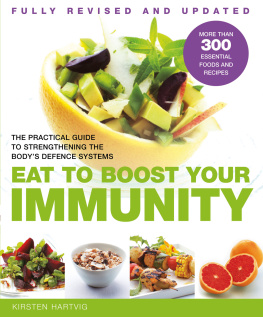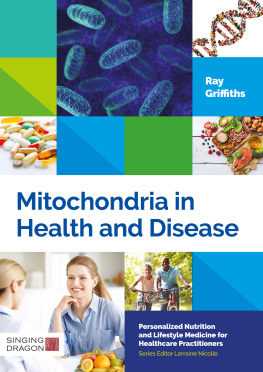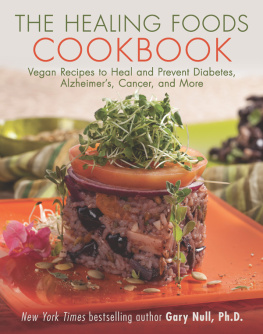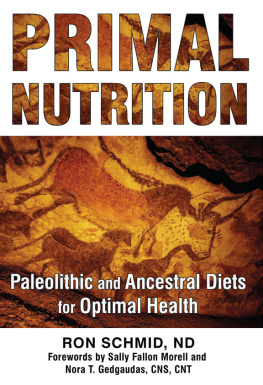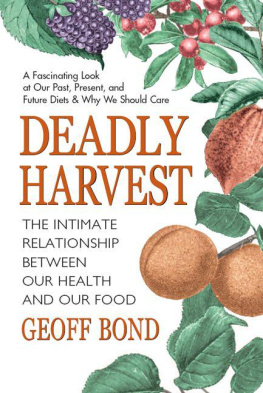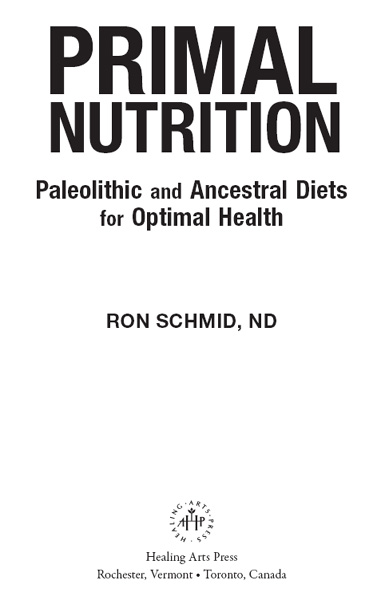Thanks to everyone for the second chances.
PRIMAL NUTRITION
Primal Nutrition is a well-researched, comprehensive resource for achieving better health with the use of traditional foods and time-honored methods of preparation. Dr. Schmid clearly explains why understanding and implementing the ancestral dietary principles outlined by Dr. Weston A. Price in his worldwide travels is critical if we are to overcome many of the health challenges of our time. This essential book is especially useful for anyone who desires to adopt all or part of a paleo diet but is confused by its various interpretations.
EDWARD BENNETT, PRESIDENT OF
THE PRICE-POTTENGER NUTRITION FOUNDATION AND
EDITOR OF THE JOURNAL OF HEALTH & HEALING
In Primal Nutrition, Dr. Ron Schmid has done a superb job of integrating the work of Weston Price, D.D.S., and Francis Pottenger, Jr., M.D., with recent research and a variety of popular diets, such as the macrobiotic diet, the Atkins diet, and the Pritikin diet. This book will be of great value for all clinicians interested in healing their patients or clients. In my opinion, it should be required reading for all medical students, dental students, nutritionists, chiropractors, naturopaths, dentists, and others in the healing arts. It will also be valuable to anyone interested in improving his or her health. I recommend it without qualification.
MICHAEL B. SCHACHTER, M.D., CNS, DIRECTOR OF THE
SCHACHTER CENTER FOR COMPLEMENTARY MEDICINE AND
CERTIFIED IN PSYCHIATRY, NUTRITION, AND CHELATION THERAPY
BY THE AMERICAN COLLEGE FOR ADVANCEMENT IN MEDICINE
Throughout my years of research and teaching food energetics, I am often asked to recommend books on the subject. Naturally and without hesitation my suggestions include Weston Prices seminal work, along with Sally Fallons Nourishing Traditions, and a few other authors who extol the many benefits of traditional foods. Ron Schmids Primal Nutrition is a welcome addition to my list.
With so many diet books available we are often confused with which direction to turn, whether its for general health maintenance or more personal health issues. Primal Nutrition is a great book for helping you get past the confusion inherent in making these choices. Schmid has a great respect for all traditional primal foods and knows well their historical role in health and their nutritional benefits. He leaves few stones unturned when it comes to supporting you in making wise and sensible decisions with diet and traditional foods.
STEVE GAGNE, AUTHOR OF
FOOD ENERGETICS: THE SPIRITUAL, EMOTIONAL, AND
NUTRITIONAL POWER OF WHAT WE EAT
Primal Nutrition brings you back to the basics of a good and healthy diet. It is well grounded and invaluable.
CHRISTOPHER VASEY, N.D., AUTHOR OF
THE ACIDALKALINE DIET FOR OPTIMUM HEALTH AND
NATURAL REMEDIES FOR INFLAMMATION
ACKNOWLEDGMENTS
The people at Inner Traditions have kept the forerunners of this book in print for over two decades. Without them this new edition would not have been possible. Years ago, Sally Fallon Morell, president of the Weston A. Price Foundation, graciously went through this books former incarnation, Traditional Foods Are Your Best Medicine, and made notes in the marginssuggestions, corrections, bits of information, and ideas for me to develop. She recently went through the manuscript of this book and did that all over again. I have incorporated nearly all of her work; any errors and omissions that remain are mine. Her constructive influence on this updated version of Traditional Foods cannot be overstated. I am so fortunate to have Sally in my corner, and I very much appreciate her writing a foreword to the volume you now hold in your hands.
I would also like to thank Nora Gedgaudas, author of Primal Body, Primal Mind, for her outstanding body of work, which has influenced mine. I would also like to thank her for writing a second foreword to this book.
The wonderful people on my staff who work with me every day make it possible for me to do the things I do. Special thanks go to my sister-in-law and brother-in-law, Elaine and Mike Stern, and my nephews Chris Stern and Nick Hughes. Our photographer and good friend Marcus Halevi hears all my ideas, good and bad, hopefully before they go anywhere and do damage. Hes been there for us for just about longer than I can remember, and we love him.
We means my wonderful wife, Elly, and I. Her sweetness lights up my life every day. Her strengths balance my weaknesses in so many ways, influencing everything I do. May it always be Ron and El, El and Ron, devoted.
FOREWORD
SALLY FALLON MORELL
Paleo and ancestral diets are in the news these days, with dozens of books on the subject, plenty of media attention, blogs, and conferences, and even special paleo labels and paleo vitamin pills! But confusion reigns as to what actually constitutes a paleo diet or ancestral diet. Is it the lean-meat, low-fat diet proposed by authors Loren Cordain and Robb Wolf? Or is it a high-fat diet that embraces bacon, liver, and lard? Should grains be included in paleo or ancestral diets? And what about dairy products?
The first researcher to describe the diets of nonindustrialized peoples was Weston Price, D.D.S., in his groundbreaking book Nutrition and Physical Degeneration. He called these diets primitive diets. During the 1930s and early 1940s, Price traveled to remote corners of the globe to study the health and diets of isolated groups. His investigations took him to remote Swiss villages and a windswept island in the Outer Hebrides. He studied traditional Eskimos, Indian tribes in Canada and the Florida Everglades, islanders of the South Seas, Aborigines in Australia, Maoris in New Zealand, and Peruvian and Amazonian Indians and tribesmen in Africa.
He studied rates of tooth decay, which were invariably very low in isolated communities. He also described dental and facial structure, noting that primitive peoples universally had straight teeth and well-developed cheeks and jawbones. He noted the absence of chronic diseases such as tuberculosis, cancer, and heart disease, and he marveled at the reproductive health of the people who lived in these villages and tribes, where women easily gave birth to sturdy children. Nutrition and Physical Degeneration provides a fascinating record of his findings, and includes the photographs he took.
The difficulty has been in making Prices findings accessible to the public, for even those individuals who take the time to read his book come away with questions. All the primitive diets he described were so different from one another, they observed. How then could Prices discoveries be translated into practical dietary advice for modern people? Some groups, like the Eskimos and northern Indians, consumed a very high-fat diet containing almost no plant foods. African agriculturists, on the other hand, lived on a plant-based diet; the animal foods they ingested were limited to insects and small fish. Dairy foods and grain provided the bulk of calories in the diet of the Swiss villager; Gaelic fisherfolk of the Outer Hebrides ate mostly seafood and oats. The most varied diets were found in the South Seas, where an abundance of fruit, vegetables, and tubers thrived in the warm climate. Despite this, however, animal foods formed the basis of the diet of these peopleeverything from shellfish to shark to pig. Some groups had lots of fat in the diet, others had plenty of carbs.
From these cursory descriptions, can we come to any conclusions about how we should eat today in order to be healthy?



